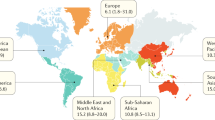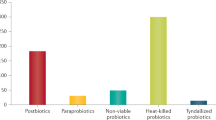Abstract
Necrotizing enterocolitis (NEC) remains a common emergency that carries high morbidity and mortality for extremely low birth weight infants. To date there have been no multicenter randomized controlled trials to evaluate different feeding strategies and NEC. Clinicians must weigh their experience against small amounts of data in deciding the best way to feed their patients. Currently published feeding protocols and evidence for the same will be reviewed. Also reviewed is the evidence for use of human milk, initiation and advancement of feedings, and the use of probiotics.
This is a preview of subscription content, access via your institution
Access options
Subscribe to this journal
Receive 12 print issues and online access
$259.00 per year
only $21.58 per issue
Buy this article
- Purchase on Springer Link
- Instant access to full article PDF
Prices may be subject to local taxes which are calculated during checkout
Similar content being viewed by others
References
Pietz J, Achanti B, Lilien L, Stepka EC, Mehta SK . Prevention of necrotizing enterocolitis in preterm infants: a 20-year experience. Pediatrics 2007; 119: e164–e170.
Spritzer R, Koolen AMP, Baerts W, Fetter WPW, Lafeber HN, Sauer PJJ . A prolonged decline in the incidence of necrotizing enterocolitis after the introduction of a cautious feeding regimen. Acta Pediatrica Scandinavica 1988; 77: 909–911.
Kamitsuka MD, Horton MK, Williams MA . The incidence of necrotizing enterocolitis after introducing standardized feeding schedules for infants between 1250 and 2500 grams and less than 35 weeks gestation. Pediatrics 2000; 105: 379–384.
Lucas A, Cole TJ . Breast milk and neonatal necrotizing enterocolitis. Lancet 1990; 336: 1519–1523.
Schanler RJ, Shulman RJ, Lau C . Feeding strategies for premature infants: beneficial outcomes of feeding fortified human milk versus preterm formula. Pediatrics 1999; 103: 1150–1157.
Sisk PM, Lovelady CA, Dillard RG, Gruber KJ, O’Shea TM . Early human milk feeding is associated with a lower risk of necrotizing enterocolitis in very low birth weight infants. J Perinatol 2007; 27: 428–433.
McGuire W, Anthony MY . Donor human milk versus formula for preventing necrotizing enterocolitis in preterm infants: systematic review. Arch Dis Child Fetal Neonatal Ed 2003; 88: 11–14.
Boyd CA, Quigley MA, Brocklehurst P . Donor breast milk versus infant formula for preterm infants: systematic review and meta-analysis. Arch Dis Child Fetal Neonatal Ed 2007; 92: 169–175.
Schanler RJ, Lau C, Hurst NM, Smith EO . Randomized trial of donor human milk versus preterm formula as substitutes for mothers’ own milk in the feeding of extremely premature infants. Pediatrics 2005; 116: 400–406.
Kennedy KA, Tyson JE . The Cochrane database of systematic reviews: early versus delayed initiation of progressive enteral feedings for parenterally fed low birth weight or preterm infants. The Cochrane Library 2004; 3.
Ronnestad A, Abrahamsen TG, Medbo S, Reigstad H, Lossius K, Kaaresen PI et al. Late-onset septicemia in a Norwegian national cohort of extremely premature infants receiving very early full human milk feeding. Pediatrics 2005; 115: e269–e276.
Tyson JE, Kennedy KA . The Cochrane database of systematic reviews: trophic feedings for parenterally fed infants. The Cochrane Library 2005; 4.
Berseth CL, Bisquera JA, Paje VU . Prolonging small feeding volumes early in life decreases the incidence of necrotizing enterocolitis in very low birth weight infants. Pediatrics 2003; 111: 529–534.
Schanler RJ, Shulman RJ, Lau C, Smith EO, Heitkemper MM . Feeding strategies for premature infants: randomized trial of gastrointestinal priming and tube-feeding method. Pediatrics 1999; 103: 434–439.
Land MH, Rouster-Stephens K, Woods CR, Cannon ML, Cnota J, Shetty AK . Lactobacillus sepsis associated with probiotic therapy. Pediatrics 2005; 115: 178–181.
Perapoch J, Planes AM, Querol A, Lopez V, Marinez-Bendayan I, Tormo R et al. Fungemia with Saccharomyces cerevisiae in two newborns, only one of whom had been treated with ultra-levura. Eur J Clin Microbiol Infect Dis 2000; 19: 468–470.
Deshpande G, Rao S, Patole S . Probiotics for prevention of necrotizing enterocolitis in preterm neonates with very low birthweight: a systematic review of randomized controlled trials. Lancet 2007; 369: 1614–1620.
Author information
Authors and Affiliations
Corresponding author
Rights and permissions
About this article
Cite this article
Parish, A., Bhatia, J. Feeding strategies in the ELBW infant. J Perinatol 28 (Suppl 1), S18–S20 (2008). https://doi.org/10.1038/jp.2008.45
Published:
Issue Date:
DOI: https://doi.org/10.1038/jp.2008.45
Keywords
This article is cited by
-
The impact of feeding interval on feeding outcomes in very low birth-weight infants
Journal of Perinatology (2011)
-
Le point sur la prématurité en 2009
Revue de médecine périnatale (2009)



